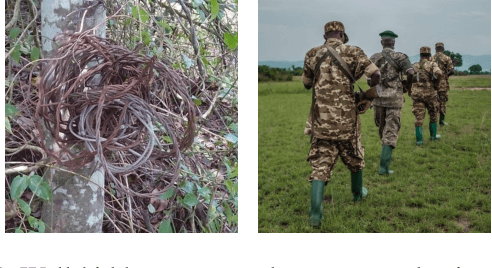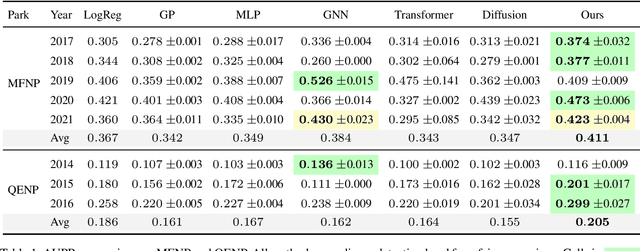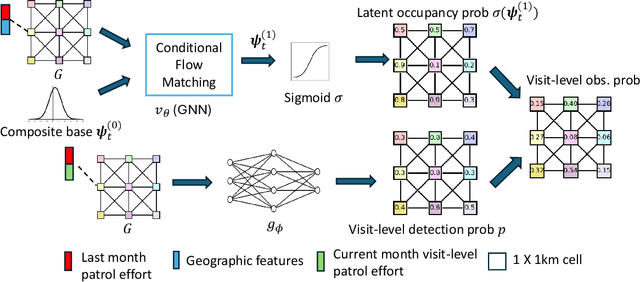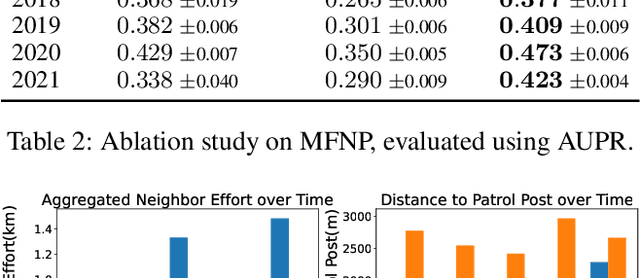Milind Tambe
Beyond Majority Voting: LLM Aggregation by Leveraging Higher-Order Information
Oct 01, 2025Abstract:With the rapid progress of multi-agent large language model (LLM) reasoning, how to effectively aggregate answers from multiple LLMs has emerged as a fundamental challenge. Standard majority voting treats all answers equally, failing to consider latent heterogeneity and correlation across models. In this work, we design two new aggregation algorithms called Optimal Weight (OW) and Inverse Surprising Popularity (ISP), leveraging both first-order and second-order information. Our theoretical analysis shows these methods provably mitigate inherent limitations of majority voting under mild assumptions, leading to more reliable collective decisions. We empirically validate our algorithms on synthetic datasets, popular LLM fine-tuning benchmarks such as UltraFeedback and MMLU, and a real-world healthcare setting ARMMAN. Across all cases, our methods consistently outperform majority voting, offering both practical performance gains and conceptual insights for the design of robust multi-agent LLM pipelines.
Generative AI Against Poaching: Latent Composite Flow Matching for Wildlife Conservation
Aug 20, 2025



Abstract:Poaching poses significant threats to wildlife and biodiversity. A valuable step in reducing poaching is to forecast poacher behavior, which can inform patrol planning and other conservation interventions. Existing poaching prediction methods based on linear models or decision trees lack the expressivity to capture complex, nonlinear spatiotemporal patterns. Recent advances in generative modeling, particularly flow matching, offer a more flexible alternative. However, training such models on real-world poaching data faces two central obstacles: imperfect detection of poaching events and limited data. To address imperfect detection, we integrate flow matching with an occupancy-based detection model and train the flow in latent space to infer the underlying occupancy state. To mitigate data scarcity, we adopt a composite flow initialized from a linear-model prediction rather than random noise which is the standard in diffusion models, injecting prior knowledge and improving generalization. Evaluations on datasets from two national parks in Uganda show consistent gains in predictive accuracy.
Beyond Listenership: AI-Predicted Interventions Drive Improvements in Maternal Health Behaviours
Jul 28, 2025Abstract:Automated voice calls with health information are a proven method for disseminating maternal and child health information among beneficiaries and are deployed in several programs around the world. However, these programs often suffer from beneficiary dropoffs and poor engagement. In previous work, through real-world trials, we showed that an AI model, specifically a restless bandit model, could identify beneficiaries who would benefit most from live service call interventions, preventing dropoffs and boosting engagement. However, one key question has remained open so far: does such improved listenership via AI-targeted interventions translate into beneficiaries' improved knowledge and health behaviors? We present a first study that shows not only listenership improvements due to AI interventions, but also simultaneously links these improvements to health behavior changes. Specifically, we demonstrate that AI-scheduled interventions, which enhance listenership, lead to statistically significant improvements in beneficiaries' health behaviors such as taking iron or calcium supplements in the postnatal period, as well as understanding of critical health topics during pregnancy and infancy. This underscores the potential of AI to drive meaningful improvements in maternal and child health.
Composite Flow Matching for Reinforcement Learning with Shifted-Dynamics Data
May 29, 2025Abstract:Incorporating pre-collected offline data from a source environment can significantly improve the sample efficiency of reinforcement learning (RL), but this benefit is often challenged by discrepancies between the transition dynamics of the source and target environments. Existing methods typically address this issue by penalizing or filtering out source transitions in high dynamics-gap regions. However, their estimation of the dynamics gap often relies on KL divergence or mutual information, which can be ill-defined when the source and target dynamics have disjoint support. To overcome these limitations, we propose CompFlow, a method grounded in the theoretical connection between flow matching and optimal transport. Specifically, we model the target dynamics as a conditional flow built upon the output distribution of the source-domain flow, rather than learning it directly from a Gaussian prior. This composite structure offers two key advantages: (1) improved generalization for learning target dynamics, and (2) a principled estimation of the dynamics gap via the Wasserstein distance between source and target transitions. Leveraging our principled estimation of the dynamics gap, we further introduce an optimistic active data collection strategy that prioritizes exploration in regions of high dynamics gap, and theoretically prove that it reduces the performance disparity with the optimal policy. Empirically, CompFlow outperforms strong baselines across several RL benchmarks with shifted dynamics.
Adaptive Frontier Exploration on Graphs with Applications to Network-Based Disease Testing
May 27, 2025Abstract:We study a sequential decision-making problem on a $n$-node graph $G$ where each node has an unknown label from a finite set $\mathbf{\Sigma}$, drawn from a joint distribution $P$ that is Markov with respect to $G$. At each step, selecting a node reveals its label and yields a label-dependent reward. The goal is to adaptively choose nodes to maximize expected accumulated discounted rewards. We impose a frontier exploration constraint, where actions are limited to neighbors of previously selected nodes, reflecting practical constraints in settings such as contact tracing and robotic exploration. We design a Gittins index-based policy that applies to general graphs and is provably optimal when $G$ is a forest. Our implementation runs in $O(n^2 \cdot |\mathbf{\Sigma}|^2)$ time while using $O(n \cdot |\mathbf{\Sigma}|^2)$ oracle calls to $P$ and $O(n^2 \cdot |\mathbf{\Sigma}|)$ space. Experiments on synthetic and real-world graphs show that our method consistently outperforms natural baselines, including in non-tree, budget-limited, and undiscounted settings. For example, in HIV testing simulations on real-world sexual interaction networks, our policy detects nearly all positive cases with only half the population tested, substantially outperforming other baselines.
Analyzing Cost-Sensitive Surrogate Losses via $\mathcal{H}$-calibration
Feb 26, 2025Abstract:This paper aims to understand whether machine learning models should be trained using cost-sensitive surrogates or cost-agnostic ones (e.g., cross-entropy). Analyzing this question through the lens of $\mathcal{H}$-calibration, we find that cost-sensitive surrogates can strictly outperform their cost-agnostic counterparts when learning small models under common distributional assumptions. Since these distributional assumptions are hard to verify in practice, we also show that cost-sensitive surrogates consistently outperform cost-agnostic surrogates on classification datasets from the UCI repository. Together, these make a strong case for using cost-sensitive surrogates in practice.
Policy-to-Language: Train LLMs to Explain Decisions with Flow-Matching Generated Rewards
Feb 18, 2025Abstract:As humans increasingly share environments with diverse agents powered by RL, LLMs, and beyond, the ability to explain their policies in natural language will be vital for reliable coexistence. In this paper, we build a model-agnostic explanation generator based on an LLM. The technical novelty is that the rewards for training this LLM are generated by a generative flow matching model. This model has a specially designed structure with a hidden layer merged with an LLM to harness the linguistic cues of explanations into generating appropriate rewards. Experiments on both RL and LLM tasks demonstrate that our method can generate dense and effective rewards while saving on expensive human feedback; it thus enables effective explanations and even improves the accuracy of the decisions in original tasks.
On Sequential Fault-Intolerant Process Planning
Feb 07, 2025Abstract:We propose and study a planning problem we call Sequential Fault-Intolerant Process Planning (SFIPP). SFIPP captures a reward structure common in many sequential multi-stage decision problems where the planning is deemed successful only if all stages succeed. Such reward structures are different from classic additive reward structures and arise in important applications such as drug/material discovery, security, and quality-critical product design. We design provably tight online algorithms for settings in which we need to pick between different actions with unknown success chances at each stage. We do so both for the foundational case in which the behavior of actions is deterministic, and the case of probabilistic action outcomes, where we effectively balance exploration for learning and exploitation for planning through the usage of multi-armed bandit algorithms. In our empirical evaluations, we demonstrate that the specialized algorithms we develop, which leverage additional information about the structure of the SFIPP instance, outperform our more general algorithm.
Finite-Horizon Single-Pull Restless Bandits: An Efficient Index Policy For Scarce Resource Allocation
Jan 10, 2025Abstract:Restless multi-armed bandits (RMABs) have been highly successful in optimizing sequential resource allocation across many domains. However, in many practical settings with highly scarce resources, where each agent can only receive at most one resource, such as healthcare intervention programs, the standard RMAB framework falls short. To tackle such scenarios, we introduce Finite-Horizon Single-Pull RMABs (SPRMABs), a novel variant in which each arm can only be pulled once. This single-pull constraint introduces additional complexity, rendering many existing RMAB solutions suboptimal or ineffective. %To address this, we propose using dummy states to duplicate the system, ensuring that once an arm is activated, it transitions exclusively within the dummy states. To address this shortcoming, we propose using \textit{dummy states} that expand the system and enforce the one-pull constraint. We then design a lightweight index policy for this expanded system. For the first time, we demonstrate that our index policy achieves a sub-linearly decaying average optimality gap of $\tilde{\mathcal{O}}\left(\frac{1}{\rho^{1/2}}\right)$ for a finite number of arms, where $\rho$ is the scaling factor for each arm cluster. Extensive simulations validate the proposed method, showing robust performance across various domains compared to existing benchmarks.
Towards Foundation-model-based Multiagent System to Accelerate AI for Social Impact
Dec 12, 2024
Abstract:AI for social impact (AI4SI) offers significant potential for addressing complex societal challenges in areas such as public health, agriculture, education, conservation, and public safety. However, existing AI4SI research is often labor-intensive and resource-demanding, limiting its accessibility and scalability; the standard approach is to design a (base-level) system tailored to a specific AI4SI problem. We propose the development of a novel meta-level multi-agent system designed to accelerate the development of such base-level systems, thereby reducing the computational cost and the burden on social impact domain experts and AI researchers. Leveraging advancements in foundation models and large language models, our proposed approach focuses on resource allocation problems providing help across the full AI4SI pipeline from problem formulation over solution design to impact evaluation. We highlight the ethical considerations and challenges inherent in deploying such systems and emphasize the importance of a human-in-the-loop approach to ensure the responsible and effective application of AI systems.
 Add to Chrome
Add to Chrome Add to Firefox
Add to Firefox Add to Edge
Add to Edge